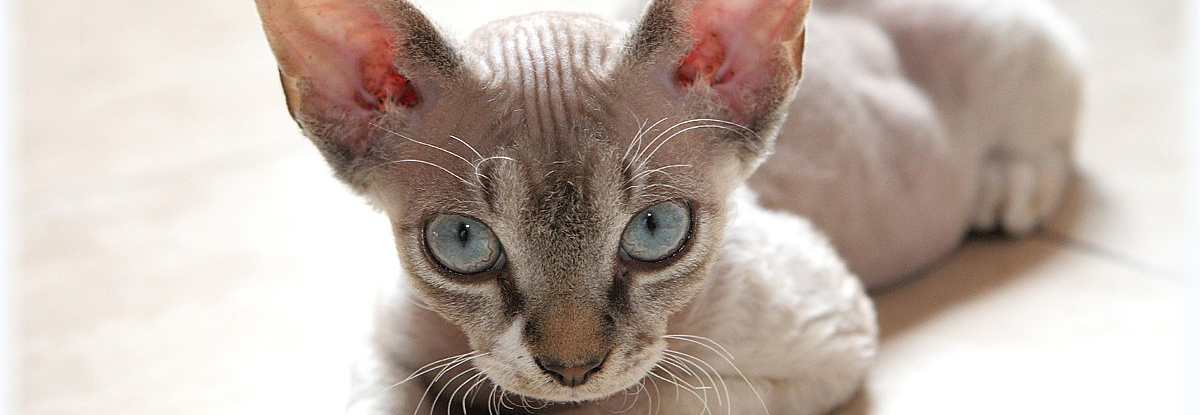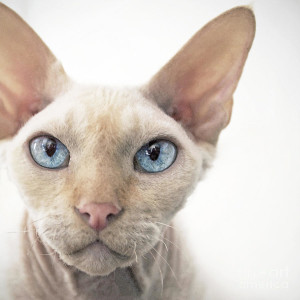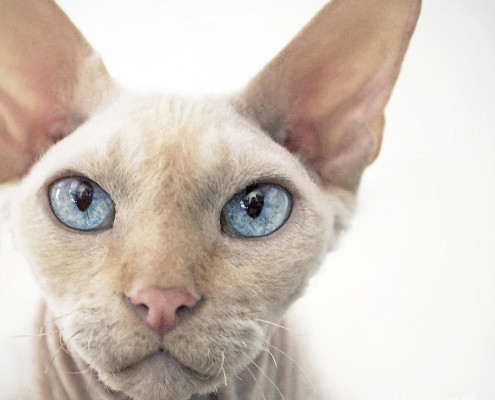Devon Rex

Meoww!!
These very intelligent cats are very playful and active. They are very giving of affection, and love a lot of attention. They require virtually no grooming because of their short coats. Some people find the Devon Rex are less likely to trigger allergies.
In 5 Words
- Short
- Curly
- Active
- Playful
- Intelligent
Snapdhot
WEIGHT RANGE:
Male: small: <8 lbs.
Female: small: <8 lbs.
EYE COLOR:
Amber, Aqua, Blue, Copper, Green, Gold, Hazel, Odd-eyed, Orange, Yellow
EXPECTATIONS:
Longevity Range: 9-13 yrs.
Social/Attention Needs: Moderate
Tendency to Shed: Low
COAT:
Length: Short
Characteristics: Curly
Colors: White, Blue, Black, Cream, Red, Brown, Frost, Platinum, Fawn, Chocolate, Chestnut, Cinnamon, Lavender, Champagne, Seal
Pattern: Solid Color, Tortoiseshell, Bicolor, Tricolor/Calico, Tabby, Ticking, Smoke, Shaded, Points
Less Allergenic: Yes
Overall Grooming Needs: Low
CLUB RECOGNITION:
Cat Association Recognition:
CFA, ACFA , TICA
Prevalence: Common

Characteristics
Learn About the Devon Rex
The Devon Rex breed stems from a curly-coated cat found in 1960 by Beryl Cox, in Devon. She attempted to take him in, but he refused to be tamed. Beryl kept an eye on the cat, though, and noticed that he had mated with a local female cat. She found the litter in a field at the end of her garden, and one of the resulting litter also had curly fur – she named the curly kitten Kirlee, and took him home. Like the Cornish Rex, the Devon’s coat is caused by a recessive gene, and inbreeding was necessary to perpetuate the breed – the Devon gene is different to that which curls the coat of the Cornish Rex, and crossing Devon and Cornish Rexes produces litters of straight-coated kittens. The two mutations must have arisen independently, despite arising so close geographically, ie in Devon and Cornwall. Within 10 years the breed was recognised in Britain.
The first impression of a Devon Rex is of an impish face and a crinkly coat. The cheeks are wide, the eyes are large, and the ears are very large, and set low on the head. The cat’s face has a distinct dip, or stop, in its profile, and the chin is well defined. The short coat has almost no guard hairs at all and is mostly made up of the undercoat of down hairs. Like the Cornish Rex, the Devon has the characteristic Rex ‘Marcel Wave’, and the fur forms ripples and waves, particularly on the back. The whiskers and eyebrows also curl, and are prone to snapping off. The legs are slender, and the hind legs are longer than the fore legs. The paws are small and oval.
The typical Devon is active, mischievous, playful, and very people-oriented. They have been described as a cross between a cat, a dog and a monkey (or, more famously, as “a monkey in a cat suit”). They are high-jumpers and will try to occupy any space large enough to admit them. With this trait, they are often found in odd nooks and crannies of a closet, shelf, or laundry basket. Devons prefer to be in high places and will go to great lengths to get to the highest spot in a room. They are relatively easy to take care of. Most Devons also have one central person to whom they devote their love, and on whom they will most often lie and rub[citation needed]. They like to playfully nip, and love to play throughout their lives.
They are a very intelligent breed; the typical Devon Rex can be trained to walk on a leash, fetch or perform all manner of tricks usually associated with canines, like jump, heel and tag to name a few.
Another common trait is their show of affection: they have a particular penchant for being close to the head or neck of their human companions and can often be found mounted upon one’s shoulder or nestled into the cranny created by the neck and shoulder when one is prone. The Devon Rex is a faithful companion and will usually follow the object of their affection from room to room, waiting for the opportunity to leap onto their arms, lap, or shoulder.
The Devon Rex should be kept inside during cold weather and provided with additional warmth, since its thin coat is often not a sufficient insulator. In the early history of the breed, a hereditary, fatal disease known as “spasticity” was developed, due to inbreeding. However, it has been bred out of current lines. Also, muscular dystrophy and hemophilia have been seen in some Devon Rexes, but breeders have attempted to breed these diseases out.
The Devon Rex cats do not moult heavily and their coat is easy to care for. A weekly going over with a baby brush is usually sufficient, while a firm stroking with the hand from head to tail will emphasize the waves of the coat. The brushing movements need to be repetitive, however delicate. Brushing will also improve the blood circulation and help avoid many unpleasant and long-lasting infections and allergies.






